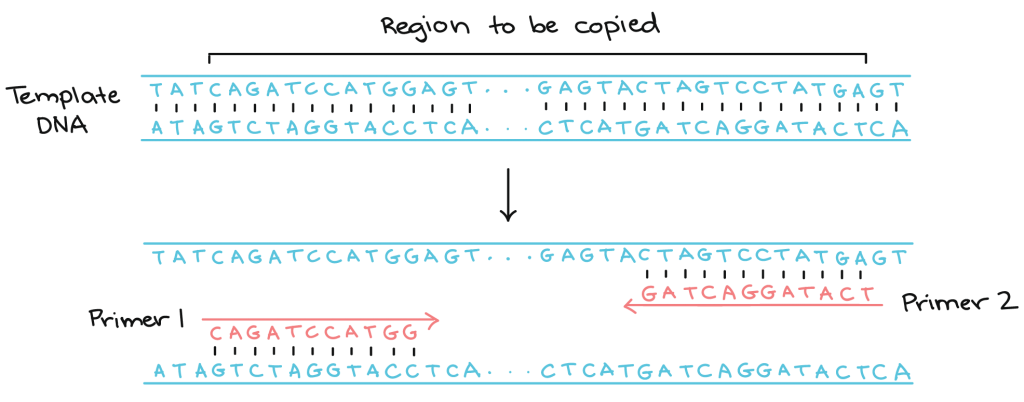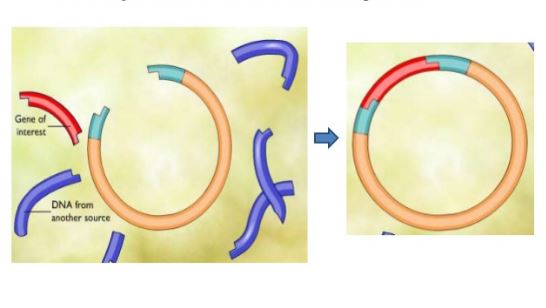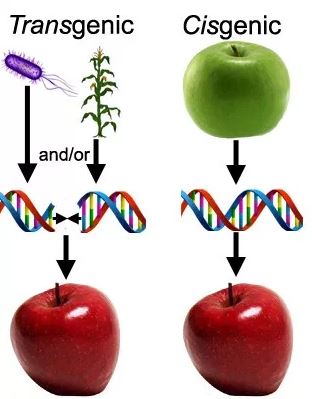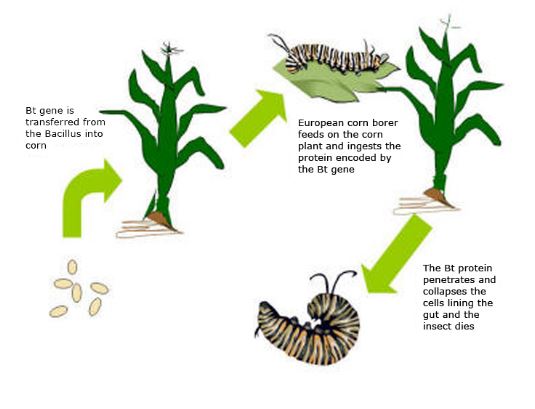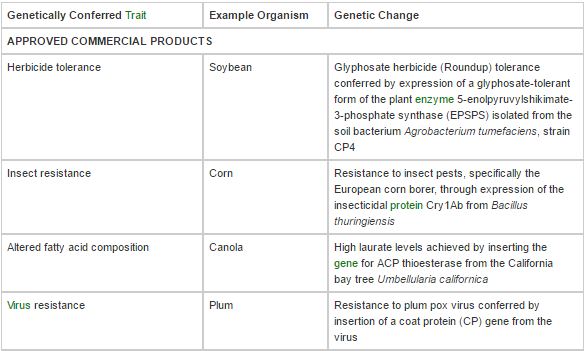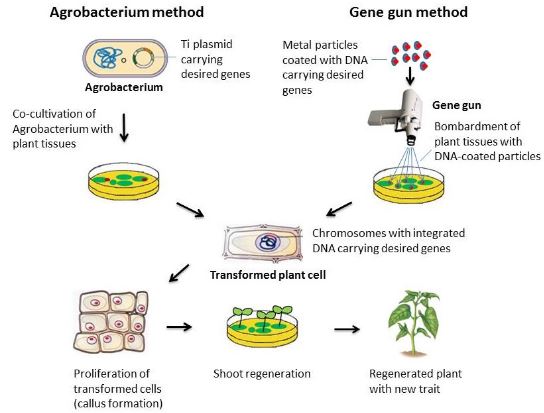In this section, we are going to introduce the Chemical Concept behind the topic of Genetically Modified Organism (GMO) and we are going to cover a few areas pertaining to it:-
- The process of adding the new DNA or genome into the food from the biological aspect of the method
- How the genes are created and selected specifically to cater to different types of food and organism
- Methods to introduce the DNA or genome into the food or organism
- The advantages and disadvantages of using enzyme/bacteria and human fabrication to create the genome
To further understand how this process is being created and used to create the GM Food, we will first look into where scientist came up with this idea of altering gene and basically how the genes are actually produced naturally. To do this, we have to look at this at the molecular level of a cell and learn the process of DNA replication, transcription and followed by translation. These three process are the root process of how cells grow, produces protein and gives different cells their shape and function.
Figure 1B: Flowchart of a Whole DNA To Protein Process (Image Citation 1B)
In DNA replication, when cells divide double stranded DNA split into 2 single strands. Each strand will act as a template for a new strand of DNA to bind through complementary base pairing. Hence each new cell will have a complete genome. Such replication is controlled by Watson-Crick pairing of the bases with the presences of DNA polymerase.
Transcription is the process where DNA is transcribed to mRNA that carries the information for protein synthesis. Pre- mRNA is formed with the aid of RNA polymerase where the only one strand is copied. The strand that contains the gene is called sense strand and the mRNA produced in transcription is a copy of the sense strand (antisense strand).
Ribonucleotide triphosphates (NTPs) align along the antisense DNA strand with Watson-Crick base pairing (A to U). RNA polymerase join the ribonucleotides together to form a pre-mRNA molecule that is complementary to a region of antisense DNA strand. Transcription comes to a stop when it reached a triplet of bases that is a “stop “signal. DNA molecule rewind and reform to double helix.
RNA splicing converts immature RNA into mature RNA as pre-mRNA contains introns that is not required for protein synthesis. Hence, alternate splicing occurs which allow individual exons to be spliced and giving rise to different possible mRNA strands. Such splicing method give rise to protein diversity where single RNA transcript give thousands of different splicing patterns and therefore code for different proteins.
After transcription is done, mRNA formed is transported out of the nucleus into the ribosome (in cytoplasm) for protein synthesis. In translation process, tRNA is required to facilitate protein synthesis. As mRNA passes through ribosome, each codon interacts with anti-codon of a specific transfer-RNA (tRNA) molecule by complementary base pairing. These tRNA molecules carries amino acid at its 3′-terminus to aid to the growing protein chain. The uncharged tRNA molecule finally leaves the ribosome.
Figure 2B: Summary Steps of the Whole GMO Food Process (Image citation 2B)
Step 1: For the identification of a trait of interest, scientists often look at the nature of the genetically modified organism (GMO). Researches look out for organisms that possess the trait which allows them to survive in a specific environment that they research for.
For example if the aim is for the improvement nutritional content of the crop, list of plants that was hypothesize to produce the nutrient of interest would be analysed.
Step 2: Once the trait of interest is being identified, genetic trait of interest would be isolated. Decoding of the portion of the organism’s genetic makeup with the trait of interest was done through comparative analysis. Such comparison can be done in various ways:
- Genomes of the plants with trait are compared to genomes in the same species with the trait.
- Genomes of the different species with the same trait is compared to identify the gene.
Short strand of genome undergo Polymerase Chain Reaction (PCR) causing gene to be multiplied to several copies.
Figure 3B: Diagram of A PCR Process (Image citation 3B)
In PCR, high temperature (96 degree) is used to denature the DNA template and the separate the 2 strands. Single stranded DNA is exposed the the region of DNA will be copied or amplified with the incoming primers. PCR primers are short single stranded DNA (approximately 20 nucleotides). Two primers are usually used in each PCR reaction and they are in sequences that will make them bind to opposite strands of the DNA template. Primers bind to template by complementary base pairing where A to T and G to C through the process of Annealing.
After the primer are bound to the template, short primers will be extended by Taq polymerase (DNA polymerase), forming new strand of DNA. This PCR reaction is repeated many times within 2-4hours where numerous copies of DNA is generated at the targeted region.
Step 3: To insert the desired genetic trait into a new genome it is necessary to alter the genome.The gene of interest has been ligated enzymatically into a plasmid (small , circular DNA molecule). This can be done by using heat denaturation or electricity to allow cells to accept the engineered plasmid.
Step 4: Once insertion genetic trait is done successfully, the modified organism needs to grow and replicated with the newly engineered genome. Genotype of the organisms is checked to ensure that the genome was modified correctly before propagation.
Optimal conditions is maintained throughout the process for seeding and growth to obtain high yield.
How genes are created and selected for different type of food
The purpose of genetically modified organism is mainly to enhance the food in certain traits such as pest and insect resistance, increase the yield of the product, to allow the food or crops to grow in much harsher conditions (extreme heat and cold), to reduce the cost of growing crops and many other reasons altogether. As some of the food or crops does not possess these genes naturally in them, scientist have ‘borrow’ the specified genes from other different organism and then insert it into the target food or crops to allow them to possess these genes.
As such, the newly genetically modified food will possess genes that are naturally from their own genome and foreign genes that comes from another organism or species. To do this, scientist must identify which food or crops naturally contains the gene of interest. From there, they will create genetic marker which are complementary to the gene of interest to identify exactly where in the genome this gene is located at. The way the genetic marker works is that it can fluoresce under UV light or contain radioactive isotope that exhibit rays when viewed under the specific machines. Once the specific gene is identified and located, scientist can then isolate the gene and add it to the new organism.
Figure 4B: Insertion of the Gene of Interest (Image Citation 4B)
Various organism used this method of borrowing genes from other organisms. Although the basis is the same where genes are being borrowed, there are three different ways to do it. There are cisgenesis, transgenesis and traditional breeding. Cisgenesis refers to taking the natural gene from a crossable and sexually compatible plant. This means that the foreign genes come from another plant of a similar species. Transgenesis refers to taking one or more genes from a non-plant species. This means that the genes added are from a species that is not sexually-compatible with plants ie; animals or insects. Traditional Breeding refers to normal breeding method that has been used for centuries. This method is a naturally occurring process where the pollen and an egg from the plant is fused together.
(Text Citation 1B)
Figure 5B: Picture of a Transgenic and Cisgenic Process (Image Citation 5B)
An example of borrowing genes from another organism will be the Bt-corn where the genes from the bacteria, Bacillus thuringiensis, is being added to the genes of corn. The reason for doing so is to allow the corn to produce pesticides on its own, without the need of manually spraying pesticide to the corn field. When the gene is being translated, it will produce Bt endotoxin or known as Bt toxin. The corn will produced enough of it to kill the insects that try to eat it mainly caterpillars. (Text Citation 2B)
Figure 6B: Process of How Bt-Corn Kills Insect Without Using Pesticide (Image Citation 6B)
Figure 7B: Different GM Food, the Genes Being Added and Its Enhancement (Image Citation 7B)
How are genes introduced and inserted into food?
There are different ways to which the foreign DNA is added to the host organism and we’ll be looking at how it is being used. The three methods are:-
- Traditional cross-breeding of plants
- Gene Gun
- Use of Bacteria
Traditional Cross-breeding of plants
The first method that we are going to look at will be the traditional cross-breeding of plants. This method has been used since the 19th century when Darwin discovered and further explored the biological concept of diversity. For his experiments, he used different types of plants and herbs to find out which offspring can have a better reproduction rate. This was the initial experiment conducted by him, without the use of any technology or machines. This way, the parent plants are able to produce offspring containing different gene due to the different arrangements during mitosis and meiosis. As he continues to breed different plants together, the offspring produced will have a great diversity and will show different characteristics. From here, some plants are able to exhibit traits which are better in surviving as compared to the others, making them more useful in growing food. After which, Gregor Mendel then continued the research on diversity but he experimented on peas instead. By cross-breeding, he is able to produce peas of different shape, size and color. (Text Citation 3B)
Figure 8B: Picture of a Traditional Cross-Breeding of A Plant (Image Citation 8B)
Gene Gun
Gene gun is another method that is used to deliver the foreign DNA into the host. This is a more technological advance way of delivery. How this gun works is that initially, a bullet must be crafted by using metal atoms. The common used metal for this process is either gold or tungsten. The metal is coated with the foreign DNA that needs to be inserted. The bullet is then fired into the target cells and it can be used by the host reproductive cells to create the new protein. (Text Citation 4B)
Using bacteria
Last but not least is using bacteria to transfer the foreign DNA into the host genome. The genome in bacteria is circular and it is called a plasmid. In the plasmid, there are many recognition sites which allows restriction enzymes to cut it and allows for different genome to be added to the plasmid. The plasmid will then be combined again to form a circular chromosome. The bacteria will then use its own enzymes for DNA replication and translation which will then produce all the proteins from the genes that was present naturally and the new protein from the foreign gene that was added. The bacteria is then introduced into the plant cell and the protein that is produced from the bacteria can be used by the plant to exhibit the specific traits. (Text Citation 5B)
Figure 9B: Summary of Agrobacterium Method and Gene Gun Method (Image Citation 9B)
Advantages and disadvantages of using enzyme and human fabrication to create the genome
Based on the different methods to create genetically modified organisms, the most conventional and mostly used method will be to use enzymes to generate the protein from the genes or for human to fabricate the protein from genes that they manufacture synthetically in the lab. Even so, both methods have their limitation and benefits and they are as follows: –


